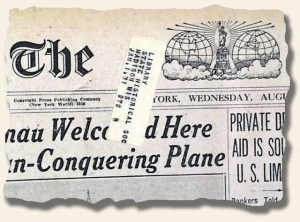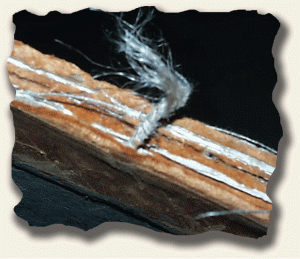Removing those annoying address labels…
November 11, 2010 by TimHughes · 2 Comments
 Fellow collector Morris Brill raises a question which others may have pondered as well: “Is there a safe way of removing the label without harming or staining the newspaper?”
Fellow collector Morris Brill raises a question which others may have pondered as well: “Is there a safe way of removing the label without harming or staining the newspaper?”
Address labels come in various sizes. The earliest ones are generally from the post-Civil War years and those labels tend to be relatively narrow strips with just the subscriber’s name or an institution’s name. A city might be included as well. Those of the 20th century tend to be one-half to three-quarters of an inch tall and contain the full address of the subscriber.
If discretely placed above the masthead & not touching any text they can be quite harmless and add a certain “charm” and authenticity to the newspaper, but those which cover portions of the masthead or headline are annoying. And they can be removed.
 In every case I’ve encountered the glue is water soluble, and once softened the label can be peeled off with little trouble. Since the label is almost always of thicker paper stock than the newspaper, the quickest way to soften the glue is to moisten the reverse side, meaning the actual newspaper from page two. Once the outline of the label is felt (or hold up to the light & note the outline), I use a cotton swab and warm water (distilled would be best) to dampen the back side of the label. Patience and experimentation are important, as often two or three applications of water and up to ten minutes of waiting are required for the glue to soften such that the label can be removed by using an exacto-knife to peel it up from a corner.
In every case I’ve encountered the glue is water soluble, and once softened the label can be peeled off with little trouble. Since the label is almost always of thicker paper stock than the newspaper, the quickest way to soften the glue is to moisten the reverse side, meaning the actual newspaper from page two. Once the outline of the label is felt (or hold up to the light & note the outline), I use a cotton swab and warm water (distilled would be best) to dampen the back side of the label. Patience and experimentation are important, as often two or three applications of water and up to ten minutes of waiting are required for the glue to soften such that the label can be removed by using an exacto-knife to peel it up from a corner.
Once removed and the dampness dries there may or may not be a minor water stain which remains, but I always find this much less offensive than the label covering part of the headline. It is my opinion that the value of the newspaper is enhanced by having the label removed despite a minor stain.
If you have had success with other methods of removing address labels, feel free to share.
Removing old newspapers from bound volumes (disbinding)…
February 19, 2009 by TimHughes · 3 Comments
 At some point along your collecting journey you may have purchased a bound volume because a particular issue was of interest, not the entire lot of 100 or more found within. Perhaps you’ve given though to taking the volume apart to secure that single issue but were afraid to cause damage. It can be done and with some practice you can find the process that works best for your particular volume.
At some point along your collecting journey you may have purchased a bound volume because a particular issue was of interest, not the entire lot of 100 or more found within. Perhaps you’ve given though to taking the volume apart to secure that single issue but were afraid to cause damage. It can be done and with some practice you can find the process that works best for your particular volume.
There were hundreds of ways newspapers were bound and each requires a personalized approach, but in general almost all have glue at the spine with various strings interwoven among the various issues. Most 18th & 19th century volumes used glue which is water soluble so Ideally it’s good to apply warm water to the exposed spine (scrape off as much of the leather as possible) and as the glue softens, scrape it off. This can take 30 minutes or more so it requires some patience. It may leave minor evidence of of water staining at the spine but the alternative of not removing glue is often leaving chunks of the spine with volume which is much more damaging.
Then use an exacto-type knife and cut as many of the strings as possible. Typically there are 4 or 5 cords running across the width of the spine around which the smaller strings, which run lengthwise down the volume, are wound. Cut at both sides of these cords and it will fall away. Then carefully lift each issue and “peel” them off much like pages of a tablet, keeping the knife handy to cut strings as they become more exposed.
 Typically the first several issues will have some damage at the spine but the remaining issues should remove more cleanly as you get the knack of the process. Best to start work on the issues as far removed from the issue you are wanting so that by time you get to your special issue you’ll have the experimenting work behind you.
Typically the first several issues will have some damage at the spine but the remaining issues should remove more cleanly as you get the knack of the process. Best to start work on the issues as far removed from the issue you are wanting so that by time you get to your special issue you’ll have the experimenting work behind you.
Twentieth century volumes are more problematic in that the glue is often not water soluble so softening & scraping away the glue may not be an option, but give it a try anyway. In such cases be as diligent as possible in cutting the strings, and as each issue reveals itself in the “peeling away” process you’ll discover the process of how the volume was bound & consequently the tricks of how best to remove the remaining issues with little or no damage.


